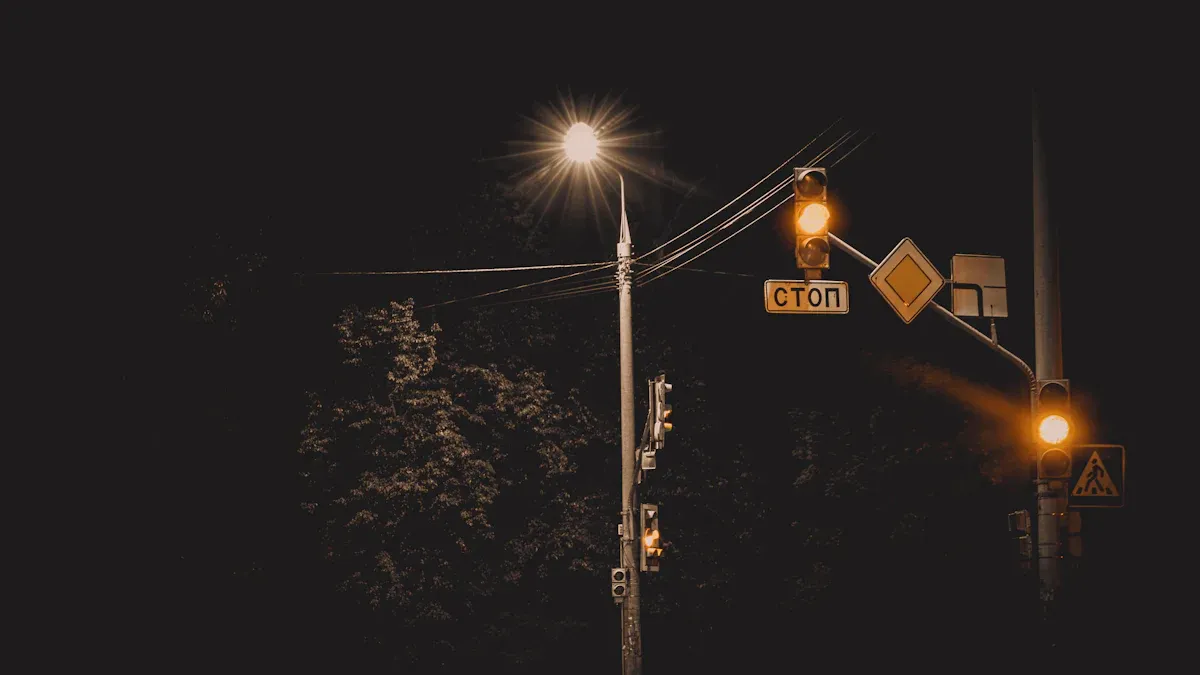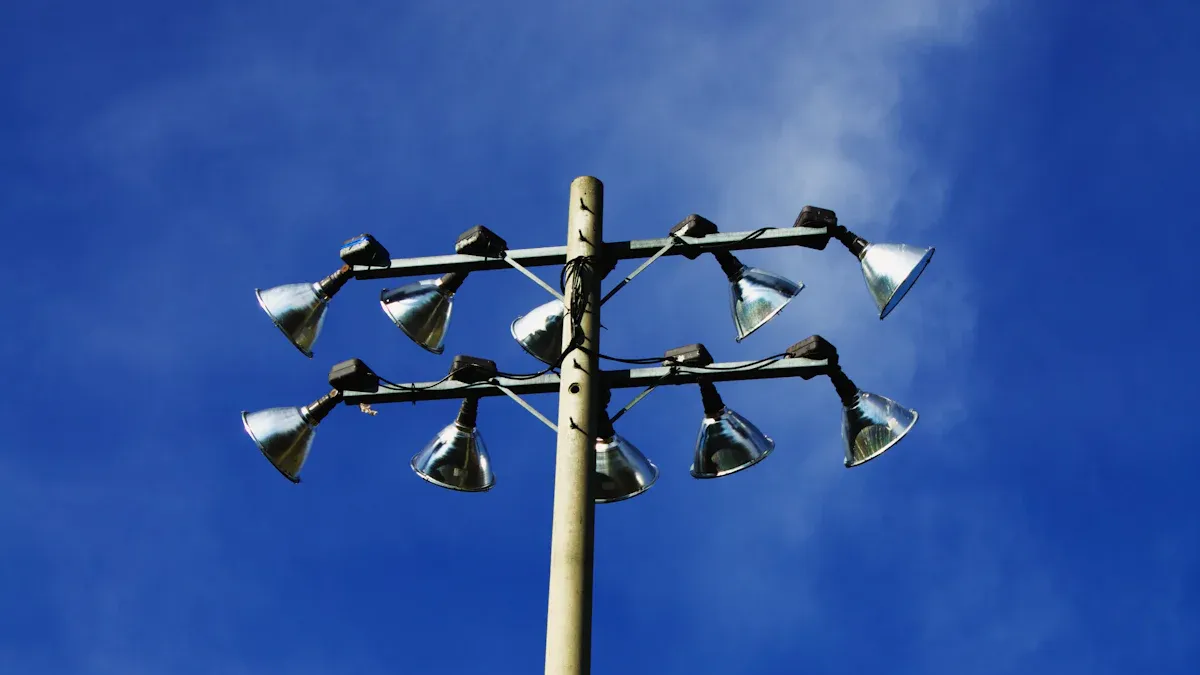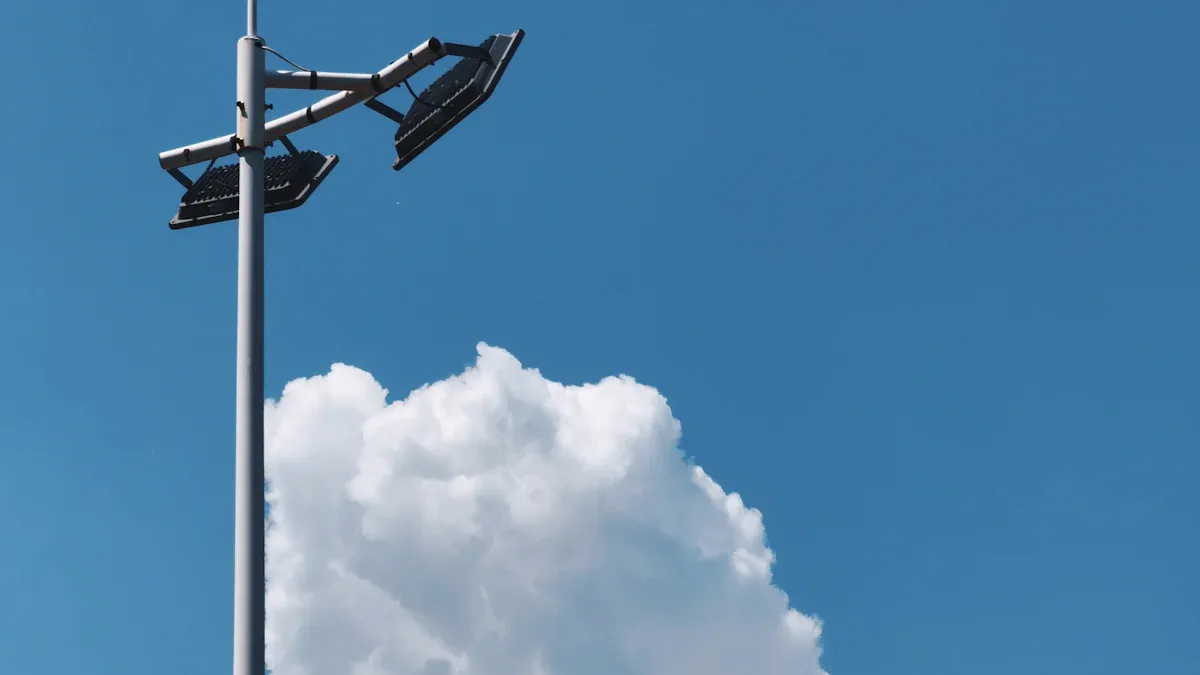Street Light Post Selection: Materials, Heights, and Installation Considerations

Selecting the right Street Light Post is crucial for safety and compliance. A well-designed Product ensures proper illumination, reducing accidents and enhancing visibility. Poor lighting can increase risks and even contribute to higher crime rates. For instance, in New York City, adding more lights reduced nighttime crimes by 36%. The choice of materials for the post impacts long-term costs—steel poles withstand harsh weather, while aluminum poles resist rust in wet environments. Solar Lights are an energy-efficient option, and LED Lights provide brighter, more reliable illumination. Choosing the right Street Light Post ensures better performance and minimizes maintenance needs over time.
Key Takeaways
Pick the right material for street light posts based on location. Steel works well in dry places. Aluminum and composite materials resist rust in wet or coastal areas.
Choose the correct height for street light posts for safety and visibility. Homes need posts 15-25 feet tall. Highways need taller posts, about 25-50 feet.
Get the site ready before installing. Check the soil type and follow local rules to make sure the post has a strong base.
Keep street lights in good shape with regular care. Look for rust, clean the lights, and fix broken parts to keep them working safely.
Use energy-saving LED lights. They use less power, cost less, and need fewer repairs over time.
Materials for Street Light Posts

Steel: Strong and Long-Lasting
Steel is a common choice for street light posts. It is strong and lasts a long time. Steel can handle tough weather like wind, rain, and snow. Galvanized steel has a special coating that stops rust and scratches. This coating covers the inside and outside of the post. It helps the post work well for many years, even in bad weather.
Steel is used in things like power towers, which last for decades. If you need something strong and durable, steel is a great pick. But steel posts are heavy, so installing them takes more effort.
Aluminum: Light and Rust-Free
Aluminum is another good material for street light posts. It is lightweight, making it easy to move and install. Aluminum is about one-third the weight of steel, which saves time and money during setup.
Aluminum doesn’t rust because it forms a protective layer when exposed to air. This layer keeps it in good shape for outdoor use. Aluminum posts need little care over time.
Feature | Aluminum Advantages |
|---|---|
Rust Protection | Creates a protective layer to stop rust and last longer. |
Lightweight Design | Weighs less than steel, making it easier to handle and install. |
Aluminum is a smart choice if you want something durable and easy to use. It works well in places near the ocean or with high humidity, where rust is a problem.
Wood: Natural and Eco-Friendly
Wooden posts give streets a natural and classic look. They fit well in parks, neighborhoods, and areas with traditional designs.
Wood is also good for the environment since it comes from renewable sources. Many companies use wood from sustainable forests. But wood needs regular care to avoid problems like rot, bugs, or weather damage. Adding protective coatings can help wood last longer.
Wood isn’t as strong as steel or aluminum, but it’s a good choice for places where looks and sustainability matter most.
Composite Materials: Strong and Modern
Composite materials are a new choice for street light posts. They mix things like fiberglass and resin to make them strong but light. These posts are great for places needing tough and low-care options.
A big plus of composite materials is they resist damage. They don’t rot like wood or rust like steel. This makes them perfect for areas with bad weather, like heavy rain or high humidity.
Another good thing is their design flexibility. Composite posts can be shaped in many ways to match your project’s look. They also come in different colors, so no painting is needed.
But composite materials cost more at first than steel or wood. Still, they last long and need little care, saving money over time. If you want a modern, tough, and easy-to-maintain option, composite materials are a smart pick.
Picking Materials Based on Location and Cost
Choosing the right material depends on where it will go and your budget. Each material has good and bad points, so think about your needs.
For places near the ocean or with lots of moisture, aluminum or composite materials are best. They don’t rust and last longer. Steel works better in dry areas with less moisture.
If you don’t have much money, wood might seem like a good idea. It’s cheap and eco-friendly but needs regular care to stay in good shape. Composite materials and aluminum cost more upfront but save money later because they last longer and need less care.
Tip: Think about how much maintenance and replacement will cost later. Spending more now can save you money in the future.
For projects that focus on looks, wood and composite materials are more flexible in design. Steel and aluminum are less stylish but very strong and great for busy areas.
By thinking about the location and your budget, you can pick a material that balances cost, strength, and style.
Determining the Right Height for Street Light Posts

Residential Streets: Balancing Safety and Looks
The height of street light posts on residential streets is important. It helps keep the area safe and makes the neighborhood look nice. If the lights are too tall, they might leave dark spots. These dark spots can make it hard to see clearly. If the posts are too short, they might cause glare. Glare can make it harder for people to see while walking or driving.
For homes and neighborhoods, street light posts should be 15 to 25 feet tall. This height gives enough light for sidewalks, driveways, and streets. Shorter posts, around 15 feet, work well for small streets with less traffic. Taller posts, up to 25 feet, are better for wide streets or busy intersections.
Tip: Pick a post height that matches your neighborhood’s style. A good match can make the lights blend in and look better.
Highways: Clear Lighting for Fast Traffic
Highways need taller street light posts for better visibility. Drivers going fast need bright, even lighting to stay safe. Tall posts also help reduce glare by keeping lights out of drivers’ direct view.
High mast lighting is common on highways and ranges from 25 to 50 feet tall. These tall posts light up large areas, so fewer poles are needed. Studies show high mast lighting makes roads safer by improving visibility and cutting down glare. The number of lights and how they are aimed also affect how well they work.
Aspect | Details |
|---|---|
High Mast Lighting | Lights up highways and reduces glare for drivers. |
Design Considerations | Includes height, number of lights, and how they are aimed. |
Visual Comfort | Keeps lights out of drivers’ direct view but lights up the road. |
When choosing highway light heights, focus on safety and clear vision. Taller posts cost more at first but help prevent accidents and improve traffic flow.
Parking Lots: Bright and Even Lighting
In parking lots, the height of street light posts affects how well the area is lit. Bad lighting can create shadows, making it hard for drivers to park. Shadows can also make it unsafe for people walking. Picking the right height ensures even lighting and better safety.
For most parking lots, posts should be 15 to 30 feet tall. Small lots do well with shorter posts, while big lots need taller ones to cover more space. To avoid shadows, use several posts with overlapping light patterns. This setup spreads light evenly across the lot.
Note: Taller posts with LED lights can save money. They need fewer fixtures and less maintenance over time.
Choosing the right height for street light posts makes parking lots safer. It also creates a welcoming space for both drivers and pedestrians.
Pedestrian Areas: Making Walking Safer and More Comfortable
Good street lighting makes walking areas safer and more welcoming. A well-lit path helps you feel safe and confident. It lowers the chance of accidents and keeps crime away. It also makes it easier to see where you’re going at night.
In walking zones, light posts are usually shorter, about 10 to 15 feet. This height lights up paths and crosswalks without causing glare. Shorter posts also fit better with people’s height, making the area feel cozy and easy to use.
To improve walking areas, think about these points:
Light Placement: Put lights evenly to avoid dark spots. Even lighting helps people see better and prevents trips.
Light Color: Pick warm or neutral colors. These colors make the area look nice and are easy on the eyes.
Energy Efficiency: Use LED lights. They save energy, last longer, and cost less to maintain.
Tip: In busy walking areas, use decorative light posts. They light up the space and make it look more attractive.
By focusing on good lighting, walking areas become safer and more enjoyable for everyone.
Rules for Street Light Heights
When choosing how tall a street light should be, follow the rules. These rules make sure the lights are safe and work well for the area.
Here are some important things to think about:
Area Purpose: Different places need different light heights. For example:
Homes and neighborhoods: 15-25 feet
Highways: 25-50 feet
Walking areas: 10-15 feet
Local Rules: Many cities have their own rules for light heights. Check with local offices to follow the rules.
Post Spacing: The space between posts affects how light spreads. Taller posts can be farther apart. Shorter posts need to be closer together.
Light Strength: The height of the post changes how bright the light looks. Taller posts need stronger lights to cover bigger spaces.
Note: The Illuminating Engineering Society (IES) has detailed rules for street lighting. Use their advice to make smart choices.
By following these rules, your street lights will be safe and work well for everyone.
Installation Considerations for Street Light Posts
Preparing the Site: Checking Soil and Location
Getting the site ready helps your street light post last. First, check the soil type and location. Different soils need different setups to stay stable. For example, sandy soil might need deeper bases than clay or rocky soil.
Follow these simple steps to prepare the site:
Learn local rules. Cities often have specific installation guidelines.
Check the area's wind strength. Strong winds can make posts unstable. Use posts that meet wind safety ratings.
Study the soil type. This helps decide how deep and strong the base should be.
By planning well, you can stop problems like leaning or wobbling later.
Building a Strong Foundation
The foundation keeps the street light post steady. A good foundation stops the post from tipping or falling, even in bad weather. Concrete is the most common choice because it’s strong and lasts long.
Think about the post’s height and weight when making the foundation. Taller posts need deeper and wider bases to stay balanced. Add steel bars to the concrete for extra strength.
In windy areas or loose soil, use anchor bolts. These bolts hold the post tightly to the base, keeping it from moving. A strong foundation makes the post safer and helps it last longer.
Wiring the Post: Safe and Reliable Connections
Good wiring is key for your street light to work well. Bad wiring can cause problems or even be dangerous. Follow these tips for safe wiring:
Feature | What to Do |
|---|---|
Use lights with built-in surge protectors (10KV or 20KV). | |
Safety Certification | Pick parts approved by trusted labs like UL or CSA. |
Cable Quality | Use strong, heat-resistant cables for better performance. |
Gasket Design | Choose gaskets without seams to avoid weak spots. |
NEMA Socket | Use a 7-pin NEMA socket with an IP66 rating for weather protection. |
Also, follow the NFPA 70, 2023 rules for safe wiring. These rules help keep the electrical system safe and working well.
By using good wiring and certified parts, your street light post will be safer and more reliable.
Safety Steps During Installation
Putting up a street light post needs careful safety steps. This helps avoid accidents and keeps the post steady for a long time.
Wear Safety Gear: Workers must use helmets, gloves, and boots to stay safe. Bright vests are needed when working near traffic.
Keep the Area Safe: Use cones or barriers to block the site. This keeps people and cars away, lowering accident risks.
Check Tools First: Look over tools and machines before using them. Broken tools can cause delays or injuries.
Follow Weight Limits: Make sure cranes or hoists don’t lift too much weight. Overloading can break equipment.
Watch the Weather: Don’t work in strong winds or heavy rain. Bad weather can make the job unsafe and weaken the post.
Tip: Teach your team what to do in emergencies. Quick actions can save lives and stop damage.
By following these safety tips, you can finish the job safely and without problems.
Maintenance Tips for Long-Lasting Posts
Taking care of your street light post keeps it working well and safe. A good plan saves money on repairs and makes the post last longer.
Check Often: Look for rust, cracks, or loose bolts regularly. Fixing small problems early stops bigger issues later.
Clean the Lights: Dirt can make lights dimmer. Clean them often to keep them bright.
Fix Broken Parts: Replace damaged bulbs or wires quickly. Using good-quality parts makes the post more reliable.
Track Energy Use: Use smart systems to check energy use. These systems adjust lights to save power and cut costs.
Follow Rules: Use advice from groups like the Illuminating Engineering Society (IES). This keeps your lights safe and efficient.
Did you know? Studies show that 30 lx brightness makes people feel safer at night. Regular care helps keep this brightness level.
A good maintenance plan improves safety and saves energy, helping the environment too.
Picking the best street light post needs careful thought. You must consider materials, height, and how to install it. These choices affect safety, strength, and following rules. For instance, using the right material helps the post handle tough weather. Choosing the correct height makes areas brighter and lowers dangers.
Tip: Talk to experts or check industry rules. This ensures your project is safe and works well. It also saves money and time in the long run.
Smart decisions make spaces safer and more useful for everyone.
FAQ
What material is best for street lights near the coast?
Aluminum or composite posts are great for coastal areas. They don’t rust or corrode from salty air and moisture. These materials also need less care, saving money over time.
How do you pick the right height for a street light?
Think about the area’s use. Homes need posts 15-25 feet tall. Highways need taller ones, 25-50 feet. Walking areas do best with shorter posts, around 10-15 feet, for safety.
Why is it important to prepare the site before installing?
Preparing the site keeps the post steady and strong. Check the soil, wind levels, and local rules. This stops problems like leaning and helps the post last longer.
How often should street lights be checked?
Check street lights every 6-12 months. Look for rust, cracks, or loose parts. Clean the lights and fix broken pieces quickly to keep them safe and bright.
Do LED lights help save energy costs?
Yes, LED lights save a lot of energy. They use less power, last longer, and need little care. Switching to LEDs can cut energy bills and help the environment.
See Also
Selecting Ideal LED Street Lights for Community Initiatives
Outdoor Signage Lighting: Varieties, Uses, and Effective Techniques
Understanding Recessed Lighting: Types, Setup, and Design Tips
Comprehensive Overview of LED Area Lights: Types and Uses
Comparing LED Streetlights and Traditional Lights: Cost and Efficiency

